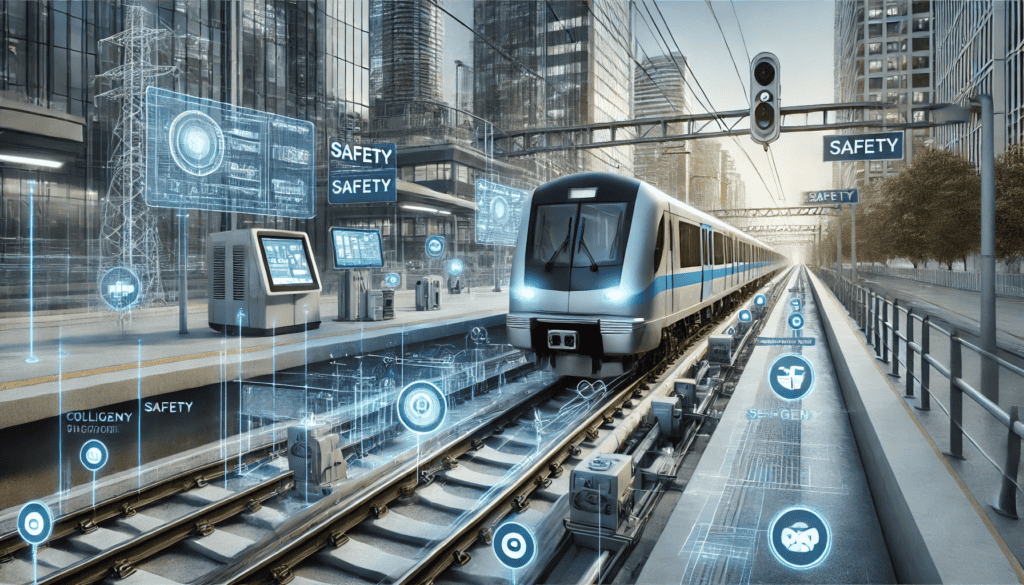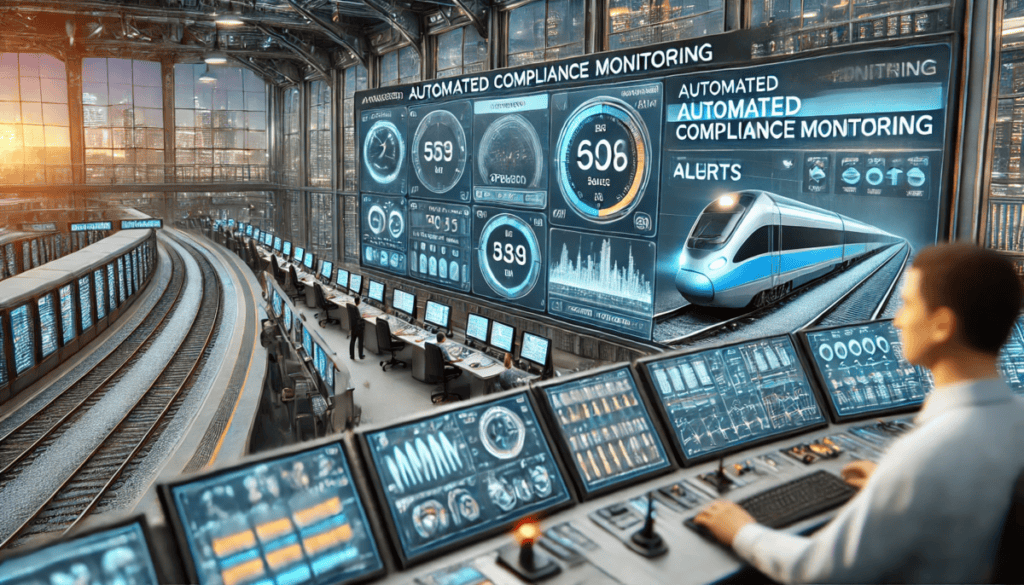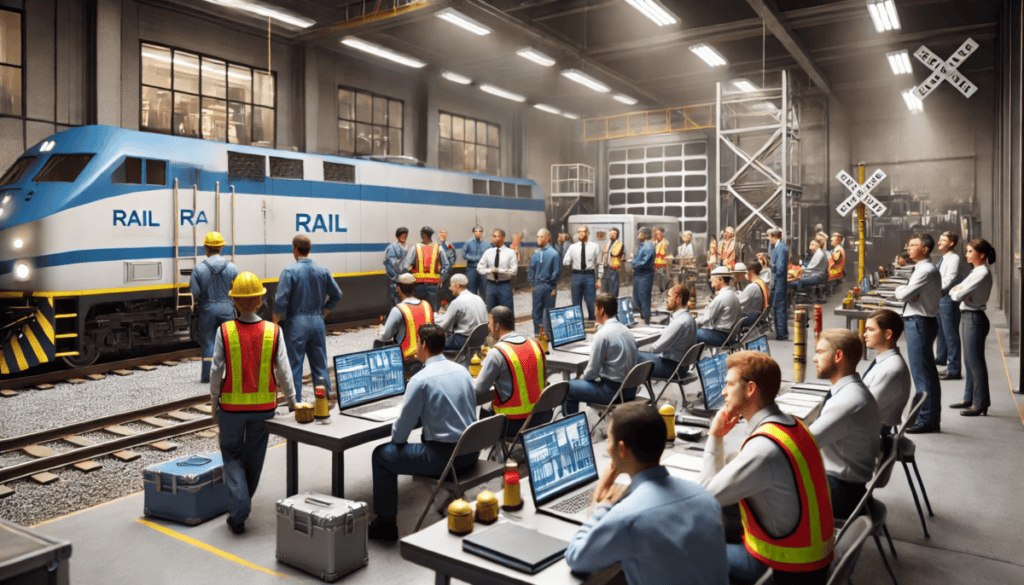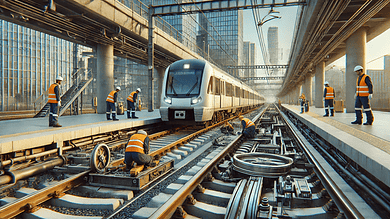Rail System Compliance Expert: A Guide for Rail Transit Agencies

Why Rail System Compliance?
Compliance in rail systems is vital for ensuring safety, operational efficiency, and regulatory adherence.
The complexity of rail operations requires strict compliance with various safety protocols, environmental regulations, operational standards, and maintenance requirements.
Failing to meet these standards can result in accidents, legal penalties, and loss of public trust.
This article explores the role of compliance experts, the requirements for maintaining compliance, and the best practices for operators to follow.
Compliance experts, particularly rail system compliance experts, play a crucial role in guiding operators through the regulatory landscape and ensuring that all rail operations meet the necessary standards.
This guidance is essential for achieving light rail safety compliance, adhering to public transit regulatory requirements, and maintaining overall system integrity.
Compliance Requirements for Rail Systems
Regulatory Framework Governing Rail Systems
Rail systems are governed by a comprehensive regulatory framework that ensures safety and efficiency. Key agencies like the Federal Transit Administration (FTA) set stringent regulations for operators.
These regulations cover various aspects of rail operations, including safety protocols, environmental impacts, operational standards, and maintenance practices.
Key Compliance Areas
- Safety Protocols: Ensuring passenger and operator safety is paramount. Regulations mandate the implementation of safety measures such as automated control systems, collision avoidance technologies, and emergency response plans. Compliance with these protocols is critical for minimizing risks and preventing accidents.
- Environmental Regulations: Rail systems must adhere to environmental regulations to minimize their impact. This includes controlling emissions, managing waste, and ensuring energy efficiency. Compliance with environmental standards not only protects the environment but also enhances the sustainability of rail operations.
- Operational Standards: Regulations dictate specific operational standards that rail systems must follow. These include guidelines for train speeds, scheduling, passenger capacity, and service quality. Adhering to these standards ensures reliable and efficient service for passengers.
- Maintenance Requirements: Regular maintenance is essential for rail systems’ safe and efficient operation. Compliance with maintenance requirements involves scheduled inspections, repairs, and upgrades to infrastructure and vehicles. This helps identify and address potential issues before they lead to significant problems.
- Transparency: Maintaining transparency through public records is crucial for ensuring accountability and building public trust. Making documents available through open document requests allows stakeholders to verify compliance, understand decision-making processes, and stay informed about rail operations’ safety and efficiency. The Federal Transportation Authority (FTA) handles public document requests under the Freedom of Information Act (FOIA). This federal law grants public access to records from any federal agency, including the FTA.
Importance of Light Rail Safety Compliance
Light rail safety compliance is crucial for protecting passengers and operators. Compliance with safety regulations ensures that light rail systems operate safely and efficiently, reducing the risk of accidents and enhancing public confidence in the transit system.
A rail system compliance expert provides the expertise to navigate these complex regulatory requirements and implement all safety measures effectively.

Role of Compliance Experts
Responsibilities of a Rail System Compliance Expert
A rail system compliance expert ensures that all rail operations comply with regulatory requirements. Their duties include interpreting regulations, developing compliance strategies, conducting audits, and providing training.
These experts have in-depth knowledge of the regulatory framework and use this expertise to guide operators in maintaining compliance.
Interpreting and Implementing Regulatory Requirements
Compliance experts assist operators in understanding and implementing regulatory requirements. They provide detailed interpretations of complex regulations, ensuring operators know their obligations. This guidance is essential for developing effective compliance strategies that align with regulatory standards.
Role of a Rail Safety Standards Expert
A rail safety standards expert is critical in auditing and assessing rail operations. These experts conduct thorough inspections to ensure all safety protocols are followed.
They evaluate operational practices, infrastructure, and vehicles to identify compliance issues. Their assessments provide valuable insights and recommendations for improving safety and achieving compliance.
Contributions to Successful Rail System Operations
Compliance experts contribute significantly to the success of rail system operations. Ensuring adherence to regulatory standards helps operators avoid legal penalties, enhance safety, and improve operational efficiency.
Their expertise in compliance management is essential for maintaining the integrity and reliability of rail systems.

Best Practices for Ensuring Compliance
Strategies for Maintaining Compliance
Operators can adopt several strategies to maintain compliance in rail operations. These include regular audits, continuous training, and effective communication. A proactive approach to compliance helps identify and address potential issues before they escalate.
Importance of Regular Audits and Inspections
Regular rail operations audits are crucial for ensuring compliance. Audits involve comprehensive evaluations of all aspects of rail operations, including safety protocols, operational standards, and maintenance practices.
Inspections help identify deviations from regulatory requirements and provide opportunities for corrective actions.
Developing and Implementing Effective Safety Management Systems
Effective safety management systems in rail are essential for maintaining compliance. These systems involve structured processes for managing safety risks, including hazard identification, risk assessment, and mitigation strategies.
Implementing robust safety management systems ensures that all safety measures are consistently applied and monitored.
Training and Educating Staff on Compliance and Safety Protocols
Training and educating staff on compliance and safety protocols is vital for maintaining a safety culture. Operators should conduct regular training sessions to ensure all employees know regulatory requirements and safety procedures. This education fosters a proactive approach to compliance and enhances overall safety.
Case Studies of Successful Compliance Management
These case studies serve as theoretical examples to demonstrate potential scenarios and outcomes. While they draw on elements that could be seen in real cases, they remain entirely speculative and are used purely for educational and illustrative purposes.
Case Study 1: City X Light Rail System
City X implemented a comprehensive compliance strategy that included regular audits, continuous staff training, and the integration of advanced safety technologies. This proactive approach led to significant improvements in safety and operational efficiency.
The system fully complied with all regulatory requirements and received recognition for its commitment to safety.
Case Study 2: Metro Y Rail Network
Metro Y faced challenges in maintaining compliance due to its aging infrastructure. The involvement of a rail safety standards expert was crucial in identifying compliance issues and recommending necessary upgrades. By implementing the expert’s recommendations, Metro Y enhanced its safety protocols and achieved compliance with all regulatory standards.

Additional Insights into Compliance Management
Integrating Technology in Compliance Management
The role of technology in compliance management cannot be overstated. Modern rail systems are increasingly adopting advanced technologies to streamline compliance processes.
For instance, automated compliance monitoring systems can continuously track operational parameters and alert operators to potential compliance issues in real time. These systems can integrate with existing rail management software to provide a holistic view of compliance status across the entire rail network.
Automated monitoring systems, for example, can track train speeds, braking patterns, and other operational metrics to ensure they remain within regulated parameters. When deviations occur, the system can alert operators and suggest corrective actions, preventing potential safety issues before they escalate into significant problems.
These technologies enhance compliance and improve rail operations’ overall safety and efficiency.
Collaborative Compliance Approaches
Collaboration between different stakeholders is essential for effective compliance management. This includes working closely with regulatory bodies, compliance experts, and internal teams.
Regular meetings and workshops can help align the goals of all stakeholders and ensure a unified approach to compliance. Collaborative efforts can also facilitate the sharing of best practices and the development of innovative compliance solutions.
For instance, rail operators can work with compliance experts to develop tailored training programs for their staff. These programs can cover the latest regulatory updates, safety protocols, and best practices for compliance.
By involving all relevant stakeholders in these training initiatives, operators can foster a culture of compliance and ensure that all employees are well-informed and vigilant about maintaining regulatory standards.
Addressing Emerging Compliance Challenges
As rail systems evolve, new compliance challenges emerge. For example, introducing autonomous rail vehicles (rolling stock) brings new regulatory considerations.
Ensuring these vehicles meet safety and operational standards requires a thorough understanding of existing regulations and emerging technologies. Compliance experts must stay abreast of technological advancements and their regulatory implications to guide operators effectively.
The advent of autonomous rail vehicles, for instance, necessitates the development of new safety protocols and operational guidelines.
Compliance experts can help operators navigate these changes by providing insights into best practices for autonomous vehicle management, conducting risk assessments, and ensuring that all new systems are thoroughly tested and certified before deployment.
The Role of Data Analytics
Data analytics plays a pivotal role in compliance management. Compliance experts can identify trends and patterns indicating potential compliance issues by analyzing operational data.
Predictive analytics can also forecast compliance risks and develop proactive mitigation strategies. Leveraging data analytics helps operators make informed decisions and enhances the overall effectiveness of compliance programs.
For example, data analytics can be used to monitor maintenance schedules and identify components that are prone to failure. By predicting when these components will likely fail, operators can perform maintenance proactively, reducing downtime and ensuring continuous compliance with safety standards.
Enhancing Public Trust Through Compliance
Maintaining compliance is not just about adhering to regulations but is also crucial in building public trust. Passengers expect rail systems to operate safely and efficiently. Demonstrating a commitment to compliance reassures the public that their safety is a top priority.
Transparent communication about compliance efforts and achievements can further enhance public confidence in the rail system.
Rail operators can leverage social media, public reports, and community engagement programs to highlight compliance efforts. For example, publishing annual safety and compliance reports can showcase the measures taken to adhere to regulatory standards and improve safety.
Engaging with passengers through surveys and feedback mechanisms can also provide valuable insights into public perception and areas for improvement.

The Human Element in Compliance
While technology and data analytics play significant roles in compliance management, the human element remains crucial. Employees at all levels must maintain high safety and compliance standards.
This commitment can be fostered through continuous training, clear communication, and a culture prioritizing safety and adherence to regulations.
Continuous Training and Education
Regular training programs are essential for informing employees about the latest regulations, safety protocols, and best practices. These programs should be designed to be engaging and relevant, incorporating real-world scenarios and interactive elements.
Compliance experts can assist in developing these training programs, ensuring they cover all necessary aspects of rail operations.
For instance, simulation-based training can provide employees with hands-on experience handling emergencies and maintaining compliance in various scenarios.
Regular refresher courses and assessments can help reinforce knowledge and ensure all employees remain current with current standards.
Clear Communication and Leadership
Effective communication is key to maintaining compliance. Leaders within the organization must communicate the importance of compliance and each employee’s role in achieving it. Regular meetings, newsletters, and updates can help keep compliance top-of-mind for all staff members.
Leadership must also lead by example, demonstrating a commitment to compliance in their actions and decisions. This includes allocating sufficient resources for compliance initiatives, supporting continuous improvement efforts, and recognizing employees who contribute to maintaining high standards.
Continuous Improvement in Compliance
Ensuring compliance in rail systems is an ongoing process that requires continuous improvement. Operators must stay updated with regulatory changes and adopt best practices for compliance management.
By maintaining a proactive approach to compliance, operators can enhance safety, improve operational efficiency, and build public trust in rail systems.
Case Study 3: Transit Authority Z
Transit Authority Z faced significant compliance challenges due to the rapid expansion and integration of new technologies. By collaborating with a rail system compliance expert and leveraging data analytics, the authority was able to identify gaps in its compliance strategies.
It implemented a robust compliance monitoring system and enhanced its training programs. As a result, it achieved full compliance with regulatory standards and improved operational efficiency and safety records.
The Role of Public Involvement in Compliance
Engaging the public and incorporating their feedback into compliance strategies can significantly enhance the effectiveness of compliance efforts. Public involvement helps build trust and ensures the rail system meets users’ needs and expectations.
Public Feedback Mechanisms
Rail operators can establish feedback mechanisms such as surveys, public forums, and social media platforms to gather input from passengers. This feedback can provide valuable insights into potential compliance issues and areas for improvement.
For instance, passengers may highlight safety concerns or service quality issues that operators might not be aware of.
Transparency in Reporting
Transparency in reporting compliance efforts and achievements can enhance public trust. Rail operators can demonstrate their commitment to maintaining high standards by publishing regular reports on safety and compliance.
These reports should include information on safety incidents, compliance audits, and measures to address identified issues.

Emerging Trends in Rail Compliance
As the rail industry evolves, new trends in compliance are emerging. Staying abreast of these trends is essential for maintaining compliance and ensuring the safety and efficiency of rail operations.
Integration of Artificial Intelligence (AI)
AI is increasingly being integrated into compliance management systems. AI can analyze vast data to identify patterns and predict potential compliance issues. For example, AI algorithms can monitor operational data to detect anomalies indicating safety risks or regulatory violations.
Adoption of Blockchain Technology
Blockchain technology is being explored to enhance transparency and accountability in rail operations. Blockchain can provide a secure and immutable record of compliance activities, making it easier to track and verify compliance with regulatory standards. This technology can also facilitate stakeholder collaboration by providing a transparent and trusted platform for sharing information.
Focus on Cybersecurity
Cybersecurity has become a critical compliance aspect as rail systems become more connected and reliant on digital technologies. Protecting rail systems against cyber threats is essential for maintaining safety and operational integrity. Compliance experts must work with cybersecurity professionals to develop and implement robust security measures.
Rail System Compliance is Critical
Compliance in rail systems is a multifaceted endeavor that requires continuous effort and collaboration. By understanding the regulatory framework, adopting best practices, and leveraging the expertise of compliance experts, operators can ensure that their rail systems operate safely and efficiently. Proactive compliance management mitigates risks and enhances public trust and operational sustainability.
With the evolving rail technology and regulations landscape, staying updated and adapting to new challenges is essential. Compliance experts, including rail system compliance experts and rail safety standards experts, will continue to play a critical role in guiding operators through these complexities. Their expertise ensures that rail systems remain compliant, safe, and efficient, benefiting passengers, operators, and the broader community.

With over forty years in public transit, Timothy Borchers is a preeminent international transit and light rail expert witness specializing in accident investigation, system safety, and industry compliance. He regularly authors authoritative articles on advanced light rail topics.

